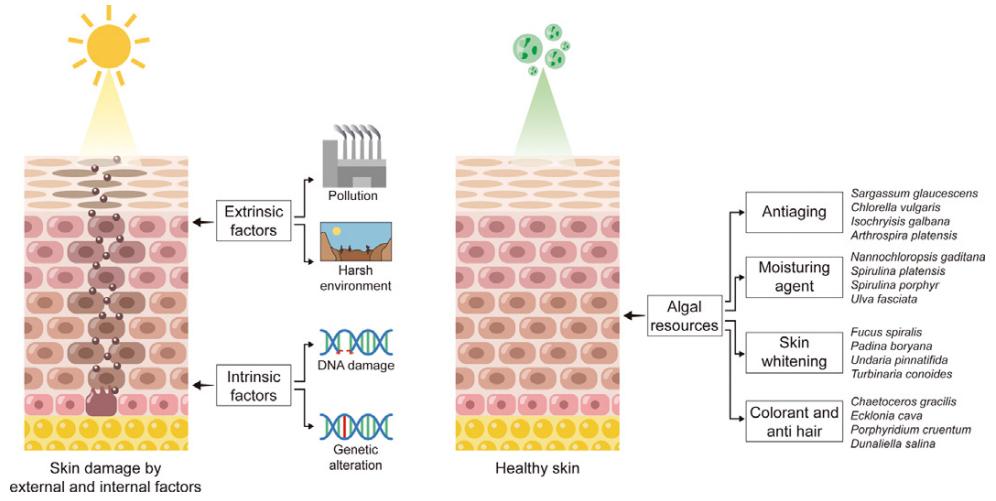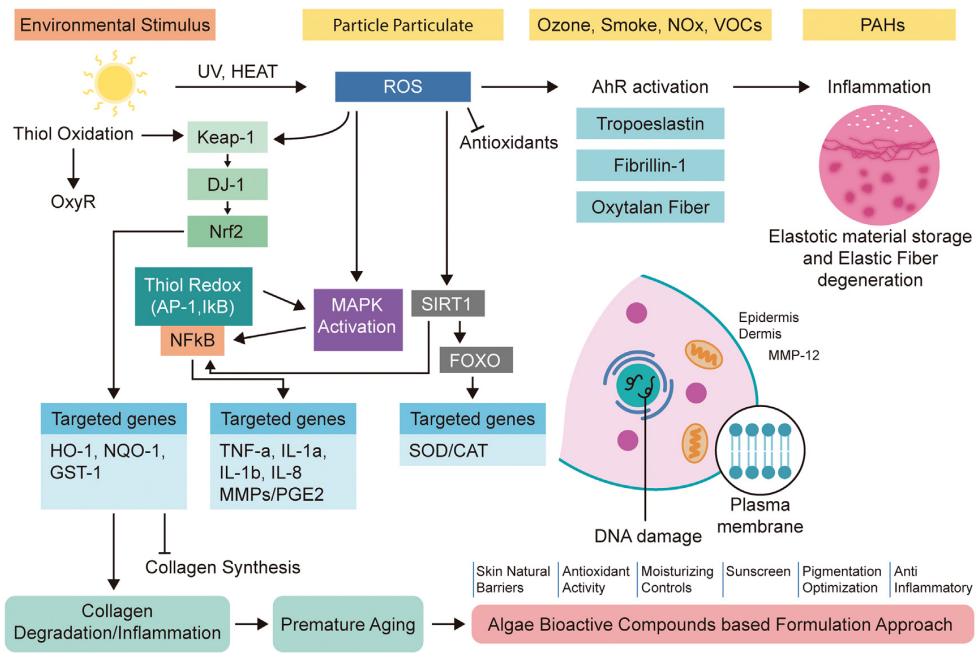Algal Production for Cosmetics
Pollution causes severe damage to human skin, leading to a greater demand for cosmetic products and for natural ingredients with a high degree of safety and efficiency in the fight against skin complications. The composition of algae contains a range of bioactive compounds that can be used to make cosmetic products to reduce environmental stress on human skin.
Human Skin Structure
The skin is the most prominent organ that covers and protects the body from physical damage. The complex texture of the skin is divided into three basic layers.
Epidermis - Containing keratinocytes, Langerhans, melanocytes, vitamin D, and sebaceous glands, which protect the skin from UV damage and determine skin color.
Dermis - Composed mainly of connective tissue, collagen, hyaluronic acid, elastin, reticulocytes, and papillary fibroblasts. The dermis and epidermal cells provide support, regenerate the skin, and preserve its moisture.
Subcutaneous Layer - Storing energy in the form of fat and acts as an insulator for the skin.
 Fig.1 Diagram of skin damage and skin protection by algal resources. (Aslam, A., et al., 2021, Science of The Total Environment)
Fig.1 Diagram of skin damage and skin protection by algal resources. (Aslam, A., et al., 2021, Science of The Total Environment)
Environmental Effects on Human Skin
Part of air pollution is particulate matter, which can cause serious damage to human skin because its diameter is 20 times smaller than the diameter of skin pores, allowing them to embed itself in the deepest layers of the skin, leading to dehydration and inflammation, an important factor in the production of reactive oxygen species (ROS).
Another key factor is ozone (O3). Exposure to O3 promotes a cascade of cellular stress responses in the deeper layers of the epidermis that can provoke a pro-inflammatory response in human epidermal keratinocytes.
 Fig.2 The effect of UV/heat and other environmental stimuli on ROS activates the activation of AhR, which induces inflammation in human skin. (Aslam, A., et al., 2021, Science of The Total Environment)
Fig.2 The effect of UV/heat and other environmental stimuli on ROS activates the activation of AhR, which induces inflammation in human skin. (Aslam, A., et al., 2021, Science of The Total Environment)
Cosmetic Ingredients Produced from Algae
Polysaccharides and lipid molecules are essential for cosmetic manufacturers. The marine green alga Ulva fasciata is known for its heteropolysaccharide content, and the brown macroalga Laminaria ochroleuca produces many compounds with moisturizing properties containing numerous unsaturated fatty acids such as linoleic, oleic, linolenic, and palmitoleic acids.
Sunscreen and sunblock protect the skin from photodamage and reduce the development of melanoma and keratinocyte carcinoma. The nitrogenous compound mycotoxin-like amino acid (MAA) can absorb UV radiation in the range of 310 to 360 nm. Extracts of the terrestrial green algae Klebsormidium and Interfilum contain two novel mycotoxin-like amino acids MAA1 and MAA2, which can be used as a natural sun blocker.
Skincare cosmetics can produce good skin texture by reducing the signs of aging. The macroalgae Macrocystis pyrifera has been extensively studied to address skin aging and its production of polyphenolic bio-compounds, such as tetrameric phloroglucinol and phlorotannins, which can act as antioxidants.
Copper-containing tyrosinase is a key enzyme that controls melanin synthesis and catalyzes melanin synthesis in two different pathways. A reasonable amount of natural phenolic compounds in the brown alga Padina boryana is successfully tested to inhibit tyrosinase and melanin by using the B16F10 murine cell model.
Our Services
With professional devices and teams, Lifeasible is capable to provide high-quality algae isolation and culture services, algae engineering services, algae analysis services, algae genetic screening services, algae-based production services, algae monitoring services, algae treatment services, and algae-based biosensor services for environmental monitoring. Please contact us for more information.
Reference
- Aslam, A., Bahadar, A., Liaquat, R., Saleem, M., Waqas, A., & Zwawi, M. (2021). Algae as an attractive source for cosmetics to counter environmental stress. Science of The Total Environment, 772, 144905.
Our services are for research use only and not for any clinical use.